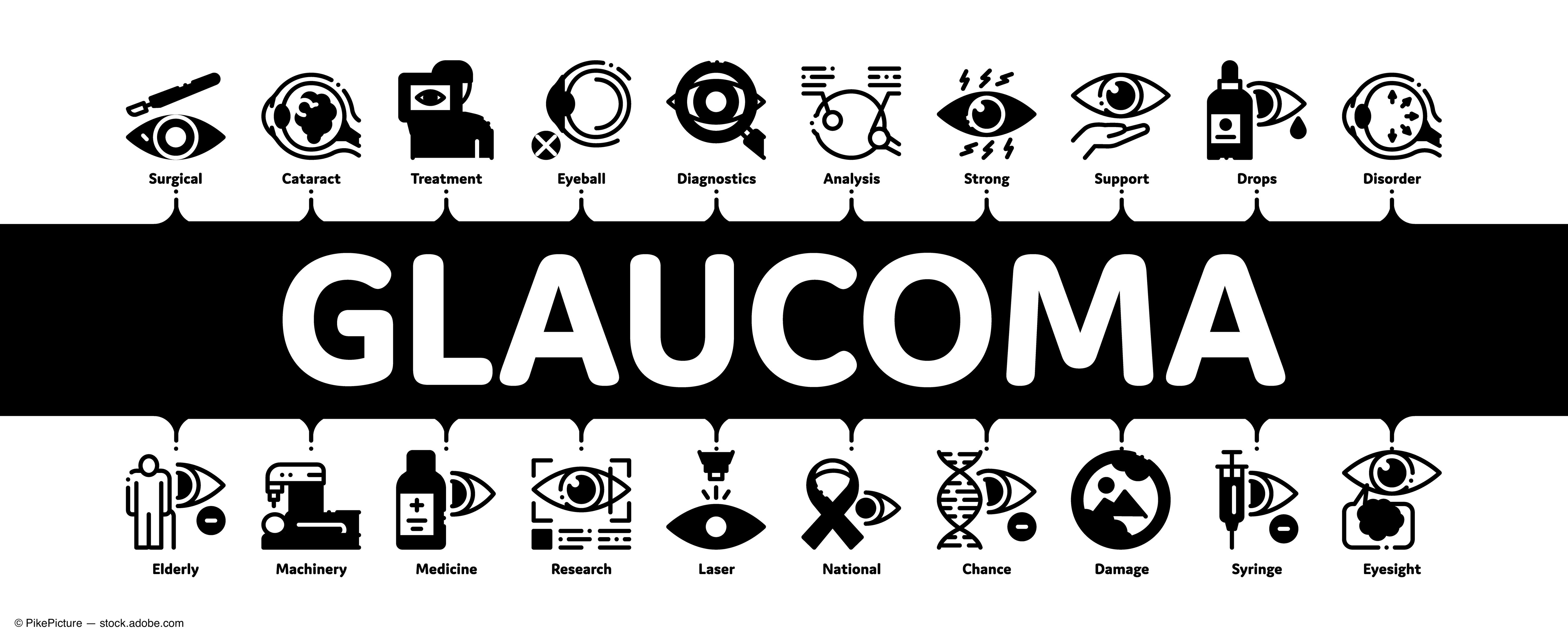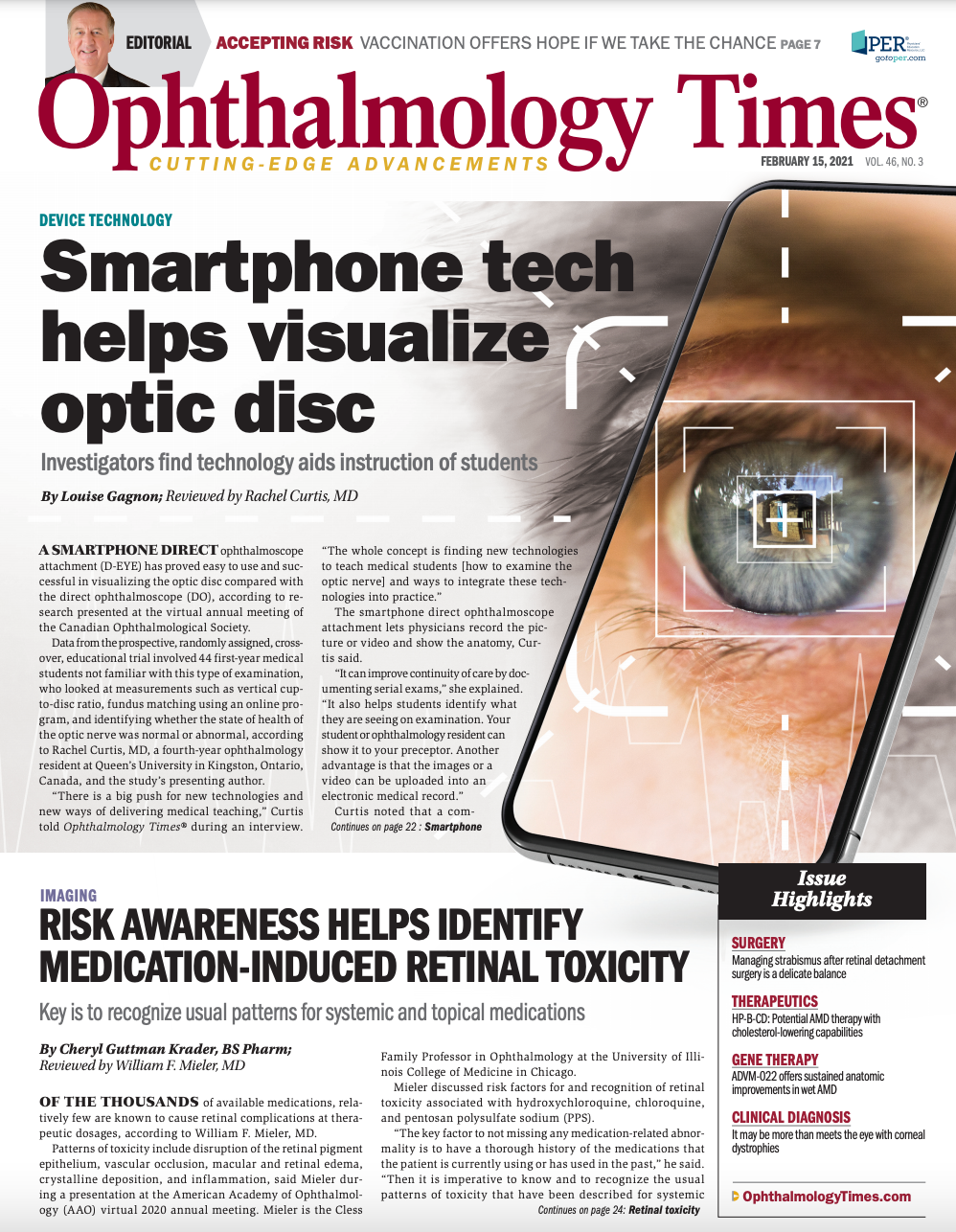Publication
Article
Digital Edition
A menu of glaucoma treatments includes options to fit all scenarios
Author(s):
Physician presents pearls for effective use, leading to positive outcomes for patients.


This article was reviewed by Michael C. Giovingo, MD
When it comes to the treatment of glaucoma, surgeons have a number of options at their disposal. Michael C. Giovingo, MD, director of Glaucoma Service at Cook County Health in Chicago, Illinois, reviewed the latest innovations and provided his pearls for their effective use.
Laser trabeculoplasty
This technology is a reliable go-to procedure that remains safe and effective, although does not satisfying the definition of a “new” glaucoma technology.
“Old data suggest that surgeons may opt to use laser trabeculoplasty both earlier in the disease process and more often,” Giovingo said. “It is effective as an initial treatment in multiple glaucoma types, and selective laser trabeculoplasty [SLT] is likely as effective as argon laser trabeculoplasty [ALT].”
Related: Controlling glaucoma uncertainty as COVID-19 limitations continue
Giovingo pointed out that data from the Glaucoma Laser Trial indicated that ALT in the long-term might reduce IOP more effectively than initial medication use.
In addition, the laser group also needed fewer glaucoma medications, visual fields were preserved better, and less progression of cupping was seen.
SLT is a relatively new way to perform a trabeculoplasty. It causes less tissue damage and has the same IOP-lowering effects as medications.
In studies, patients undergoing SLT as a first-line therapy require significantly fewer additional treatments when compared with patients started on drops initially, more than a quarter of whom required more medications.
SLT is used by many clinicians late in the disease process, but there are a significant amount of data to support it as a first-line treatment for early glaucoma and ocular hypertension, as seen in the high success rate found in the LIGHT study results.1
Study authors found that, at 36 months, 93% of the primary SLT group were at a goal pressure compared with 91.3% of the medication first group who were at goal pressure.
Related: Developments in glaucoma offering hope, options
That is not all. Micropulse technology has emerged as another newer, less destructive way to perform a trabeculoplasty. Micropulse laser trabeculoplasty (MLT) likely provides a similar efficacy compared with SLT but has even less tissue destruction.
Unlike SLT, there is no feedback (ie, “champagne bubbles”) when the clinician is applying the laser. The clinician also does not titrate the power. When performing MLT, it is also important to treat the entire 360° of the trabecular meshwork as a 180° treatment is ineffective.2
Cyclophotocoagulation
Cyclophotocoagulation (CPC) procedures are very successful in lowering IOP and medication use.
Transscleral CPC, a continuous wave diode laser, delivers thermal energy to the ciliary body, destroying the cells and decreasing aqueous production.
A G-Probe (Iridex) is held in an upright fashion on the sclera to deliver the energy posterior to the limbus in multiple discreet delivery points.
A newer probe, such as the G-Probe Illuminate, uses fiberoptics to help the clinician easily identify the ciliary body for more focused treatments.
This technology generally is reserved for eyes with lower visual potential due to a significant risk of inflammation postoperatively, but it is very successful in lowering IOP.
Related: Analyzing effects of corneal biomechanics on IOP
A continuous-wave diode laser was also combined with endoscopic cameras to create endoscopic cyclophotocoagulation (ECP) (Endo Optiks E2 laser and endoscopy system, BVI). This technology allows for direct application of the laser to the ciliary body instead of across the sclera.
In this procedure, a fiber-optic probe applies CPC to the ciliary process under direct visualization on a monitor. ECP works in the same manner as standard transscleral CPC, destroying ciliary body cells and decreasing aqueous production.
The main benefit is that there is less collateral damage as the laser is applied directly and not across surrounding tissues.
This procedure can also be combined with cataract surgery. Multiple studies show a significant reduction in both IOP and number of medications while maintaining a good safety profile and low rate of hypotony or phthisis.
Another newer method to lower IOP is micropulse CPC, performed transsclerally, and delivers power in short bursts. The probe is held externally and angled directly toward the center of the globe, and delivered in a sweeping fashion along the limbus.
Related: Single administration of intracameral bimatoprost implant: IOP lowering, safety
The procedure seems simple on the surface, but if the probe is held improperly or used without a coupling gel, there will be a significant reduction in the delivery of energy to the target tissue.3
The procedure can be performed in-office or in the operating room using the MP3 probe, held perpendicular to the sclera, and delivered in a sweeping fashion approximately 1 to 2 mm posterior to the limbus.
The benefits of this procedure are that it creates low amounts of inflammation and tissue destruction.
Many studies have demonstrated long-term efficacy of micropulse CPC and Sarrafpour et al also demonstrated that the amount of IOP reduction increases when amplifying the power used for the treatment.4
Given these data, when performing a repeat treatment, Giovingo prefers using higher power settings.
Related: Multi-pressure dial: A new approach to lowering IOP and treating glaucoma
Iridex’s next probe iteration, the Revision 2 Probe, was recently released. It is much more ergonomic and has advanced ease of use.
The manufacturer recommends 50 seconds per hemisphere instead of 80 to 120 seconds administered previously using the original MP3 probe. Long-term safety and efficacy data on the new probe are still being collected.
“Overall, these lasers can fill in multiple gaps that exist in the glaucoma treatment landscape and in personal treatment algorithms,” he said.
Minimally invasive glaucoma surgeries
Besides being minimally invasive, these surgeries are characterized by short surgical times, rapid recoveries and can be performed both at the same time as cataract surgery or as standalone procedures.
Minimally invasive glaucoma surgeries (MIGS) do a number of different jobs, such as remove/bypass the resistance, reform Schlemm’s canal (SC), shunt aqueous to the suprachoroidal space, and have a blebless surgery that lowers IOP significantly as a goal, Giovingo explained.
Related: Optimizing and modifying newer glaucoma surgeries
The trabecular bypass MIGS include the iStent (Glaukos Corporation), which is placed across the trabecular meshwork (TM) and facilitates direct aqueous drainage from the anterior chamber (AC) to SC.
Injection of 2 iStents proved to be more efficacious than 1 and resulted in the iStent Inject with a more direct insertion method.
The Hydrus Microstent (Ivantis), also placed across the TM, has scaffolding extending into SC to facilitate a TM bypass, as well as stents open the canal distal to the bypass allowing for more flow.
Trabecular excision MIGS include the Trabectome (MST) that cuts and cauterizes the TM to prevent scarring. The Kahook Dual Blade (New World Medical), a single-use blade, makes dual parallel incisions in the TM, thus forming a direct path for aqueous flow from the AC to SC.
Finally, Bent Ab-interno Needle Goniectomy is a similar procedure that simply uses a bent 25 gauge needle to excise a strip of TM similarly to the Kahook Dual Blade (presented at the 2019 American Glaucoma Society meeting by Thomas Shute, MD). Early results show promise, but no long-term data are available.
Related: Clear lens extraction surgery: Pinpointing the optimal time in glaucoma patients
Suprachoroidal MIGS devices include the CyPass (Alcon), which was the only such device available in the United States. The device performed well but was discontinued because of decreased endothelial cell counts in comparison with phacoemulsification alone at 5 years.
The iStent Supra, also from Glaukos Corporation, is another suprachoroidal device but has not yet been approved for sale. Several similar devices are still in development, but no suprachoroidal devices are available for use within the United States.
Canaloplasty devices feature gonioscopy-assisted transluminal trabeculotomy (GATT), a modified trabeculotomy, in which a Prolene Polypropylene Suture (Johnson & Johnson) is inserted into the SC and ripped out into the AC to create the trabeculotomy.
The iTrack (Ellex) is similar to GATT but also includes an illuminated catheter to ensure proper positioning of the device and improve safety.
The Omni Surgical System (Sight Sciences) is capable of canaloplasty with viscodilation. It delivers a probe into the SC and viscodilates as the device is withdrawn. The surgeon can also perform a trabeculotomy simultaneously.
Related: Evaluating long-term safety of micro-bypass implant with phaco in PXG
Transscleral devices may or may not be considered MIGS. The current option includes the Xen Glaucoma Implant (Allergan), made from a noninflammatory gel, which creates an outflow path from the AC to the subconjunctival space. The procedure can be performed alone or with cataract surgery.
The InnFocus device (Santen Pharmaceutical) is another transscleral device that is placed externally into the AC.
Both of these devices have significant potential for lower pressure because they are not limited by episcleral venous pressure, but they carry many of the same risks seen with other bleb-forming surgeries such as trabeculectomy.
Conclusion
“Overall, there is a continuum for the MIGS procedures,” Giovingo concluded. “The procedures that are lower risk, the trabecular bypass and excision procedures, are associated with less IOP lowering. The canaloplasty and suprachoroidal procedures and the transscleral devices are considered higher risk but have greater IOP-lowering capabilities.”
--
Michael C. Giovingo, MD
e:MCgiovingo@gmail.com
Giovingo is a speaker for and receives research support from Iridex and receives research support from Santen Pharmaceutical.
--
References
1. Gazzard G, Konstantakopoulou E, Garway-Heath D, et al. Selective laser trabeculoplasty versus eye drops for first-line treatment of ocular hypertension and glaucoma (LIGHT): a multicentre randomized controlled trial. Lancet. 2019;393(10180):1505-1516. doi:10.1016/S0140-6736(18)32213-X
2. Patel S, Kakouri A, Chaudhary S, et al. The effect of various media and probe angles on the power output of the Cyclo G6 Glaucoma Laser System. Lasers Med Sci. Published online July 18, 2020. doi:10.1007/s10103-020-03089-w
3. Rantala E, Välimiäki J. Micropulse diode laser trabeculoplasty --180-degree treatment. Acta Ophthalmol. 2012;90(5):441-444. doi:10.111/j.10.1111/j.1755-3768.2010.02026.x
4. Sarrafpour S, Saleh D, Ayoub S, Radcliffe N. Micropulse transscleral cyclophotocoagulation: a look at long-term effectiveness and outcomes. Ophthalmol Glaucoma. 2019;2(3):167-171. doi:10.1016/j.ogla.2019.02.002

Newsletter
Don’t miss out—get Ophthalmology Times updates on the latest clinical advancements and expert interviews, straight to your inbox.
2 Commerce Drive
Cranbury, NJ 08512
All rights reserved.




